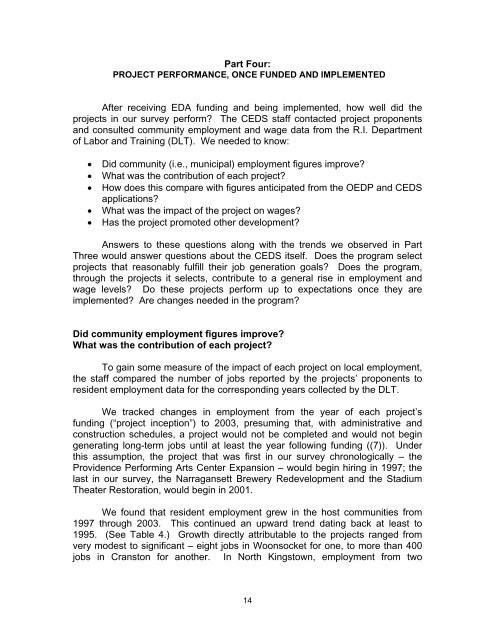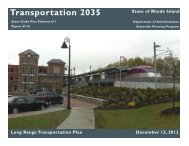156: EDA Public Works in RI, 1996-2000 - State of Rhode Island ...
156: EDA Public Works in RI, 1996-2000 - State of Rhode Island ...
156: EDA Public Works in RI, 1996-2000 - State of Rhode Island ...
Create successful ePaper yourself
Turn your PDF publications into a flip-book with our unique Google optimized e-Paper software.
Part Four:<br />
PROJECT PERFORMANCE, ONCE FUNDED AND IMPLEMENTED<br />
After receiv<strong>in</strong>g <strong>EDA</strong> fund<strong>in</strong>g and be<strong>in</strong>g implemented, how well did the<br />
projects <strong>in</strong> our survey perform? The CEDS staff contacted project proponents<br />
and consulted community employment and wage data from the R.I. Department<br />
<strong>of</strong> Labor and Tra<strong>in</strong><strong>in</strong>g (DLT). We needed to know:<br />
• Did community (i.e., municipal) employment figures improve?<br />
• What was the contribution <strong>of</strong> each project?<br />
• How does this compare with figures anticipated from the OEDP and CEDS<br />
applications?<br />
• What was the impact <strong>of</strong> the project on wages?<br />
• Has the project promoted other development?<br />
Answers to these questions along with the trends we observed <strong>in</strong> Part<br />
Three would answer questions about the CEDS itself. Does the program select<br />
projects that reasonably fulfill their job generation goals? Does the program,<br />
through the projects it selects, contribute to a general rise <strong>in</strong> employment and<br />
wage levels? Do these projects perform up to expectations once they are<br />
implemented? Are changes needed <strong>in</strong> the program?<br />
Did community employment figures improve?<br />
What was the contribution <strong>of</strong> each project?<br />
To ga<strong>in</strong> some measure <strong>of</strong> the impact <strong>of</strong> each project on local employment,<br />
the staff compared the number <strong>of</strong> jobs reported by the projects’ proponents to<br />
resident employment data for the correspond<strong>in</strong>g years collected by the DLT.<br />
We tracked changes <strong>in</strong> employment from the year <strong>of</strong> each project’s<br />
fund<strong>in</strong>g (“project <strong>in</strong>ception”) to 2003, presum<strong>in</strong>g that, with adm<strong>in</strong>istrative and<br />
construction schedules, a project would not be completed and would not beg<strong>in</strong><br />
generat<strong>in</strong>g long-term jobs until at least the year follow<strong>in</strong>g fund<strong>in</strong>g ((7)). Under<br />
this assumption, the project that was first <strong>in</strong> our survey chronologically – the<br />
Providence Perform<strong>in</strong>g Arts Center Expansion – would beg<strong>in</strong> hir<strong>in</strong>g <strong>in</strong> 1997; the<br />
last <strong>in</strong> our survey, the Narragansett Brewery Redevelopment and the Stadium<br />
Theater Restoration, would beg<strong>in</strong> <strong>in</strong> 2001.<br />
We found that resident employment grew <strong>in</strong> the host communities from<br />
1997 through 2003. This cont<strong>in</strong>ued an upward trend dat<strong>in</strong>g back at least to<br />
1995. (See Table 4.) Growth directly attributable to the projects ranged from<br />
very modest to significant – eight jobs <strong>in</strong> Woonsocket for one, to more than 400<br />
jobs <strong>in</strong> Cranston for another. In North K<strong>in</strong>gstown, employment from two<br />
14

















